Platinum-Group Minerals of Pt-Placer Deposits Associated with the Svetloborsky Ural-Alaskan Type Massif, Middle Urals, Russia
Abstract
:1. Introduction
2. Materials and Methods
2.1. Geological Setting
2.2. Sample Collection and Preparation
2.3. Analytical Methods
3. Results
3.1. Morphological Features
3.2. Chemical Composition of Platinum-Group Minerals
3.2.1. Pt-Fe Alloys
3.2.2. Os-Ir-Ru Alloys
3.2.3. PGE sulfides
3.2.4. Pt-Ir-Rh Thiospinels
3.2.5. Other Platinum Group Minerals
3.3. Mineral Assemblages—A Comparison
4. Discussion
5. Conclusions
Author Contributions
Funding
Acknowledgments
Conflicts of Interest
References
- Zaitsev, A.M. Platinum Deposits in the Urals; M.N. Kononov and I.F. Skulimovskiy: Tomsk, Russia, 1898; p. 74. (In Russian) [Google Scholar]
- Vysotsky, N.K. Platinum deposits of Isovskoy and Nizhnetagilsky areas on the Urals. Proc. Geol. Comm. 1913, 62, 1–694. (In Russian) [Google Scholar]
- Zavaritsky, A.N. Lode Platinum Deposits on the Urals; Publishing House of the Geological Committee: Saint Petersburg, Russia, 1928; p. 56. (In Russian) [Google Scholar]
- Lazarenkov, V.G.; Malitch, K.N.; Sakhyanov, L.O. Platinum Metal Mineralization of Zonal Ultrabasic and Comatiite Massifs; Nedra: Leningrad, Russia, 1992; p. 217. (In Russian) [Google Scholar]
- Ivanov, O.K. Zoned Ultramafic Complexes of Ural (Mineralogy, Petrology, Genesis); Publishing House of Uralsky Mining University: Ekaterinburg, Russia, 1997; p. 488. (In Russian) [Google Scholar]
- Garuti, G.; Pushkarev, E.; Zaccarini, F. Composition and paragenesis of Pt alloys from chromitites of the Uralian-Alaskan type Kytlym and Uktus complexes, Northern and Central Urals, Russia. Can. Mineral. 2002, 40, 357–376. [Google Scholar] [CrossRef]
- Auge, T.; Genna, A.; Legendre, O.; Ivanov, K.S.; Volchenko, Y.A. Primary platinum mineralization in the Nizhny Tagil and Kachkanar ultramafic complexes, Urals, Russia: A genetic model for PGE concentration in chromite-rich zones. Econ. Geol. 2005, 100, 707–732. [Google Scholar] [CrossRef]
- Pushkarev, E.V.; Anikina, E.V.; Garuti, G.; Zaccarini, F. Chrome-platinum mineralization of the Nizhny Tagil type in the Urals: Structural and material characteristics and the problem of genesis. Lithosphere 2007, 3, 28–65. (In Russian) [Google Scholar]
- Tolstykh, N.D.; Telegin, Y.M.; Kozlov, A.P. Platinum mineralization of the Svetloborsky and Kamenushinsky massifs (Urals Platinum Belt). Russ. Geol. Geophys. 2011, 52, 603–619. [Google Scholar] [CrossRef]
- Zaccarini, F.; Garuti, G.; Pushkarev, E.V. Unusually PGE-rich chromitite in the Butyrin vein of the kytlym Uralian-Alaskan complex, Northern Urals, Russia. Can. Mineral. 2011, 49, 1413–1431. [Google Scholar] [CrossRef]
- Tolstykh, N.D.; Kozlov, A.P.; Telegin, Y.M. Platinum mineralization of the Svetly Bor and Nizhny Tagil intrusions, Ural Platinum Belt. Ore Geol. Rev. 2015, 67, 234–243. [Google Scholar] [CrossRef]
- Malitch, K.N.; Stepanov, S.Y.; Badanina, I.Y.; Khiller, V.V. Bedrock platinum-group elements mineralization of zonal clinopyroxenite-dunite massifs of the Middle Urals. Dokl. Earth Sci. 2017, 476, 1147–1151. [Google Scholar] [CrossRef]
- Palamarchuk, R.S.; Stepanov, S.Y.; Khanin, D.A.; Antonov, A.V. PGE Mineralization of Massive chromitites of the Iov dunite body (Northern Urals). Mosc. Univ. Geol. Bull. 2017, 72, 68–76. [Google Scholar] [CrossRef]
- Stepanov, S.Y.; Kozlov, A.V.; Malitch, K.N.; Badanina, I.Y.; Antonov, A.V. Platinum group element mineralization of the Svetly bor and Veresovy bor clinopyroxenite-dunite massifs, Middle Urals, Russia. Geol. Ore Depos. 2017, 59, 244–255. [Google Scholar] [CrossRef]
- Malitch, K.N.; Thalhammer, O.A.R. Pt-Fe nuggets derived from clinopyroxenite-dunite massifs, Russia: A structural, compositional and osmium-isotope study. Can. Mineral. 2002, 40, 395–418. [Google Scholar] [CrossRef]
- Barannikov, A.G.; Osovetsky, B.M. Platinum and platinum containing placers of the Urals, the criteria and signs of their spatial connection with primary sources. News Ural State Min. Univ. 2014, 35, 12–29. (In Russian) [Google Scholar]
- Stepanov, S.Y.; Pilyugin, A.G.; Zolotarev, A.A., Jr. Comparison of the compositions of the platinum group minerals of the chromitites and placers of the Nizhny Tagil massif, Middle Urals. J. Min. Inst. 2015, 211, 22–28. (In Russian) [Google Scholar]
- Tolstykh, N.D.; Krivenko, A.P.; Sidorov, E.G.; Laajoki, K.V.O.; Podlipskiy, M. Ore mineralogy of PGM placers in Siberia and the Russian Far East. Ore Geol. Rev. 2002, 20, 1–25. [Google Scholar] [CrossRef]
- Tolstykh, N.D.; Sidorov, E.G.; Laajoki, K.V.O.; Krivenko, A.P.; Podlipskiy, M. The association of platinum-group minerals in placers of the Pustaya river, Kamchatka, Russia. Can. Mineral. 2000, 38, 1251–1264. [Google Scholar] [CrossRef]
- Vildanova, E.Y.; Zaitsev, V.P.; Kravchenko, L.I.; Landa, E.A.; Litvinenko, A.F.; Markovskij, B.A.; Melkomukov, V.N.; Mochalov, A.G.; Nazimova, Y.V.; Popruzhenko, S.V.; et al. Koryak-Kamchatka Region is A New Platinum-Bearing Province of Russia; Publishing House of VSEGEI: St. Petersburg, Russia, 2002; p. 383. (In Russian) [Google Scholar]
- Tolstykh, N.D.; Sidorov, E.G.; Kozlov, A.P. Platinum-group minerals in lode and placer deposits associated with the Ural-Alaskan-type Gal’moenan complex, Koryak-Kamchatka platinum belt, Russia. Can. Mineral. 2004, 42, 619–630. [Google Scholar] [CrossRef]
- Sidorov, E.G.; Tolstykh, N.D.; Podlipsky, M.Y.; Pakhomov, I.O. Placer PGE minerals from the Filippa clinopyroxenite-dunite massif (Kamchatka). Russ. Geol. Geophys. 2004, 45, 1128–1144. [Google Scholar]
- Oberthur, T.; Weiser, T.W.; Melcher, F. Alluvial and eluvial platinum-group minerals from the Bushveld complex. S. Afr. J. Geol. 2014, 117, 255–274. [Google Scholar] [CrossRef]
- Oberthur, T. The fate of Platinum-Group Minerals in the Exogenic Environment–From Sulfide Ores via Oxidized Ores into Placers: Case Studies Bushveld Complex, South Africa, and Great Dyke, Zimbabwe. Minerals 2018, 8, 581. [Google Scholar] [CrossRef]
- Palamarchuk, R.S.; Stepanov, S.Y.; Khanin, D.A.; Antonov, A.V.; Zolotarev, A.A., Jr. Comparative characteristics of platinum group minerals from the eluvial placer and chromitites of the Svetloborsky clinopyroxenite-dunite massif (Middle Urals). Mineralogy 2017, 4, 37–50. (In Russian) [Google Scholar]
- Cabri, L.J.; Feather, C.E. Platinum-iron alloys: Nomenclature based on a study of natural and synthetic alloys. Can. Mineral. 1975, 13, 117–126. [Google Scholar]
- Zaccarini, F.; Bindi, L.; Pushkarev, E.; Garuti, G.; Bakker, R.J. Multi-analytical characterization of minerals of the bowieite-kashinite series from the Svetly Bor complex, Urals, Russia, and comparison with worldwide occurences. Can. Mineral. 2016, 54, 461–473. [Google Scholar] [CrossRef]
- Mertie, J.B. Economic Geology of the Platinum Metals; United States Government Printing Office: Washington, DC, USA, 1969.
- Cabri, L.J.; Harris, D.C.; Weiser, T.W. The mineralogy and distribution of Platinum Group Mineral (PGM) placer deposits of the world. Explor. Min. Geol. 1996, 5, 73–167. [Google Scholar]
- Weiser, T.W. Platinum-group minerals (PGM) in placer deposits. In The Geology, Geochemistry, Mineralogy and Mineral Beneficiation of Platinum-Group Elements; Cabri, L.J., Ed.; Canadian Institute of Mining, Metallurgy and Petroleum (CIM): Westmount, QC, Canada, 2002; CIM Special Volume 54, pp. 721–756. [Google Scholar]
- Slansky, E.; Johan, Z.; Ohnenstetter, M.; Barron, L.M.; Suppel, D. Platinum mineralization in the Alaskan-type intrusive complexes near Fifield, N.S.W., Australia, Part 2. Platinum-group minerals in placer deposits at Fifield. Mineral. Petrol. 1991, 43, 161–180. [Google Scholar] [CrossRef]
- Nixon, G.; Cabri, L.J.; Laflamme, J.H.G. Platinum-group-element mineralization in lode and placer deposits associated with the Tulameen Alaskan-type complex, British Columbia. Can. Mineral. 1990, 28, 503–535. [Google Scholar]
- Legendre, O.; Auge, T. Alluvial platinum-group minerals from the Manampotsy area, East Madagascar. Aust. J. Earth Sci. 1992, 39, 389–404. [Google Scholar] [CrossRef]
- Johan, Z.; Slansky, E.; Kelly, D.A. Platinum nuggets from the Kompiam area, Enga Province, Papua New Guinea: Evidence for an Alaskan-type complex. Mineral. Petrol. 2000, 68, 159–176. [Google Scholar] [CrossRef]
- Johan, Z.; Ohnenstetter, M.; Fisher, W.; Amosse, J. Platinum-group minerals from the Durance River Alluvium, France. Mineral. Petrol. 1990, 42, 287–306. [Google Scholar] [CrossRef]
- Podlipskii, M.Y.; Sidorov, E.G.; Tolstykh, N.D.; Krivenko, A.P. Cobalt-bearing malanite and other Pt-thioshpinels from the Maior river placers (Kamchatka). Russ. Geol. Geophys. 1999, 40, 645–648. [Google Scholar]
- McClenaghan, M.B.; Cabri, L.J. Review of gold and platinum group element (PGE) indicator minerals methods for surficial sediment sampling. Geochemistry 2011, 11, 251–264. [Google Scholar] [CrossRef]
- Volchenko, Y.A.; Ivanov, K.S.; Koroteev, V.A.; Auge, T. Structural and materal evolution of the complexes of Ural Platinum-supporting Belts while forming the chromite-platinum deposits of the Ural type, Part I. Lithosphere 2007, 3, 3–27. [Google Scholar]
- Mosin, K.I. The History of Platinum Mining in the Urals; Nizhne Turinskaya Printing House: Nizhnyaya Tura, Russia, 2002; p. 246. (In Russian) [Google Scholar]
- Palamarchuk, R.; Stepanov, S.; Kozlov, A. The characteristics of placer platinum mineralization associated with Urakian-Alaskan massifs, Middle Urals, Russia. In Proceedings of the 13th International Platinum Symposium, Polokwane, South Africa, 30 June–6 July 2018; pp. 152–153. [Google Scholar]
- Duparc, L.; Tikhonowitch, M. Le Platine et Les Gites Platiniferes de l’Oural et du Monde; Quarto: Geneve, Switzerland, 1920; p. 542. [Google Scholar]
- Kutyrev, A.V.; Sidorov, E.G.; Antonov, A.V.; Chubarov, V.M. Platinum-group mineral assemblage of the Prizhimny Creek (Koryak Highland). Russ. Geol. Geophys. 2018, 59, 935–944. [Google Scholar] [CrossRef]
- Amosse, J.; Dable, P.; Allibert, M. Thermochemical behavior of Pt, Ir, Rh, and Ru vs fO2 and fS2 in a basaltic melt. Implications for the differentiation and precipitation of these elements. Mineral. Petrol. 2000, 68, 29–62. [Google Scholar]
- Nekrasov, I.Y.; Lennikov, A.M.; Oktyabrsky, R.A.; Zalishchak, B.L.; Sapin, V.I. Petrology and Platinum-Bearingness of Ring Alkaline-Ultrabasic Complexes; Laverov, N.P., Ed.; Nauka: Moscow, Russia, 1994; p. 381. (In Russian) [Google Scholar]
- Kessel, R.; Beckett, J.R.; Stolper, E.M. Thermodynamic properties of the Pt-Fe system. Am. Mineral. 2001, 86, 1003–1014. [Google Scholar] [CrossRef]
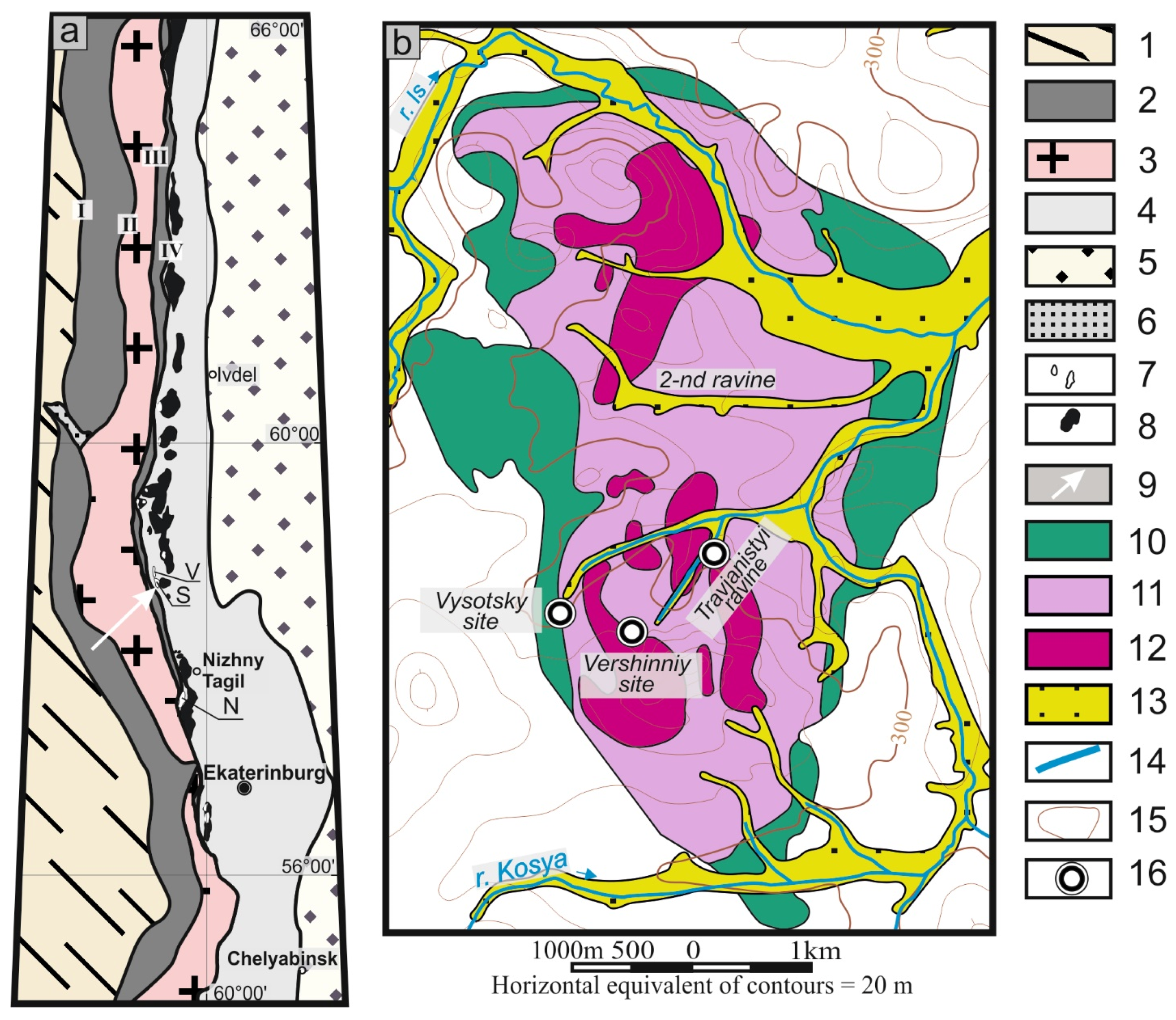
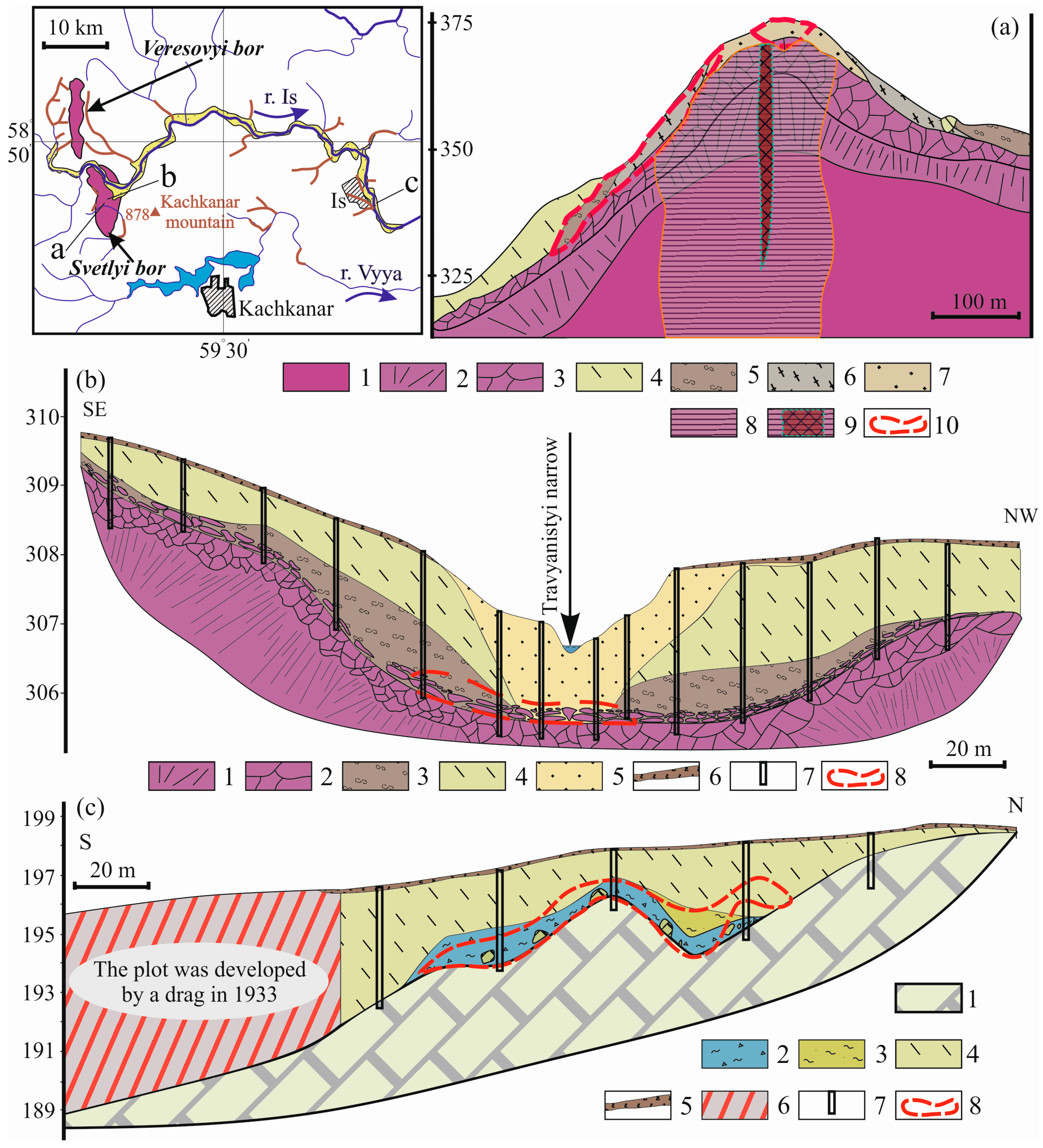
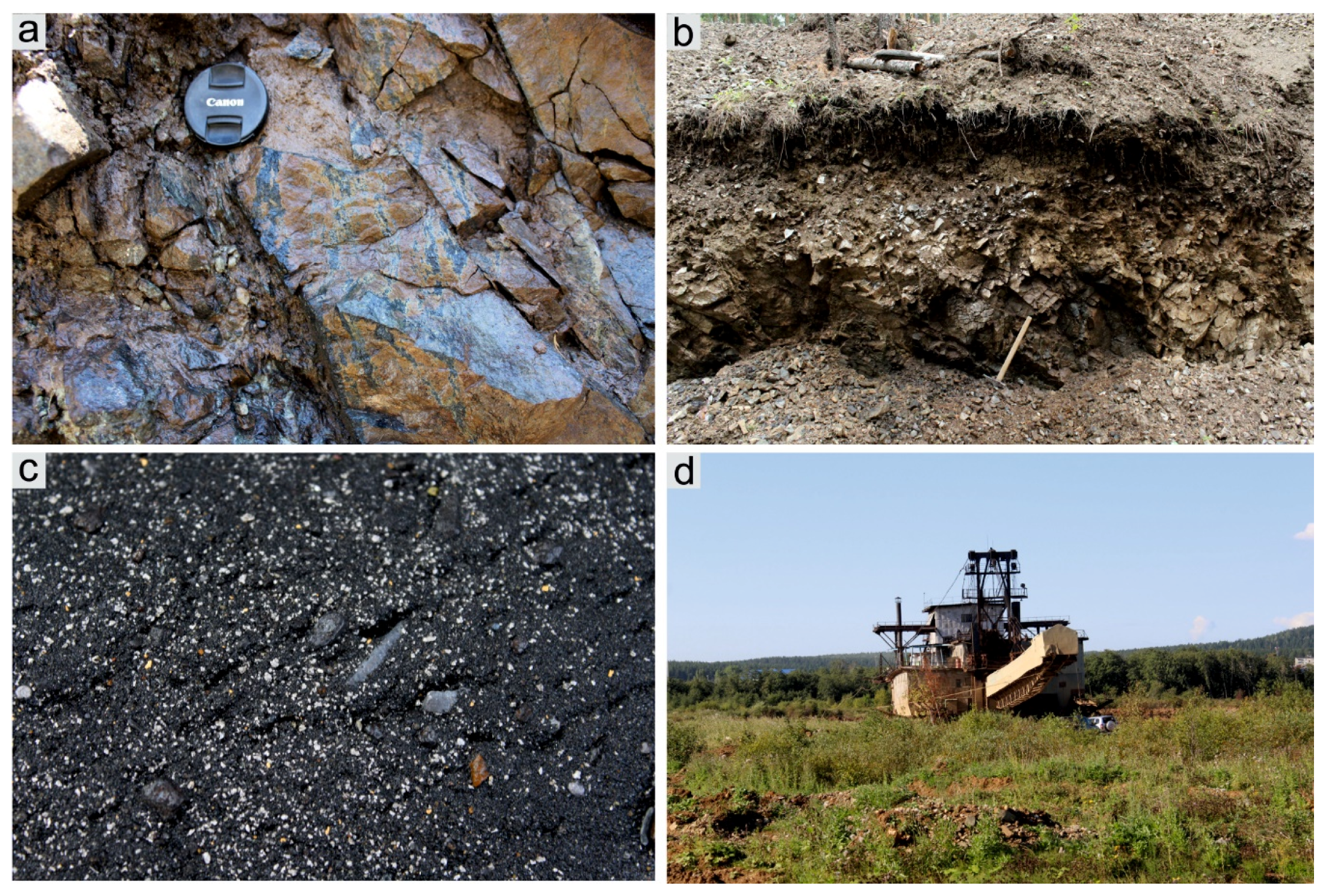
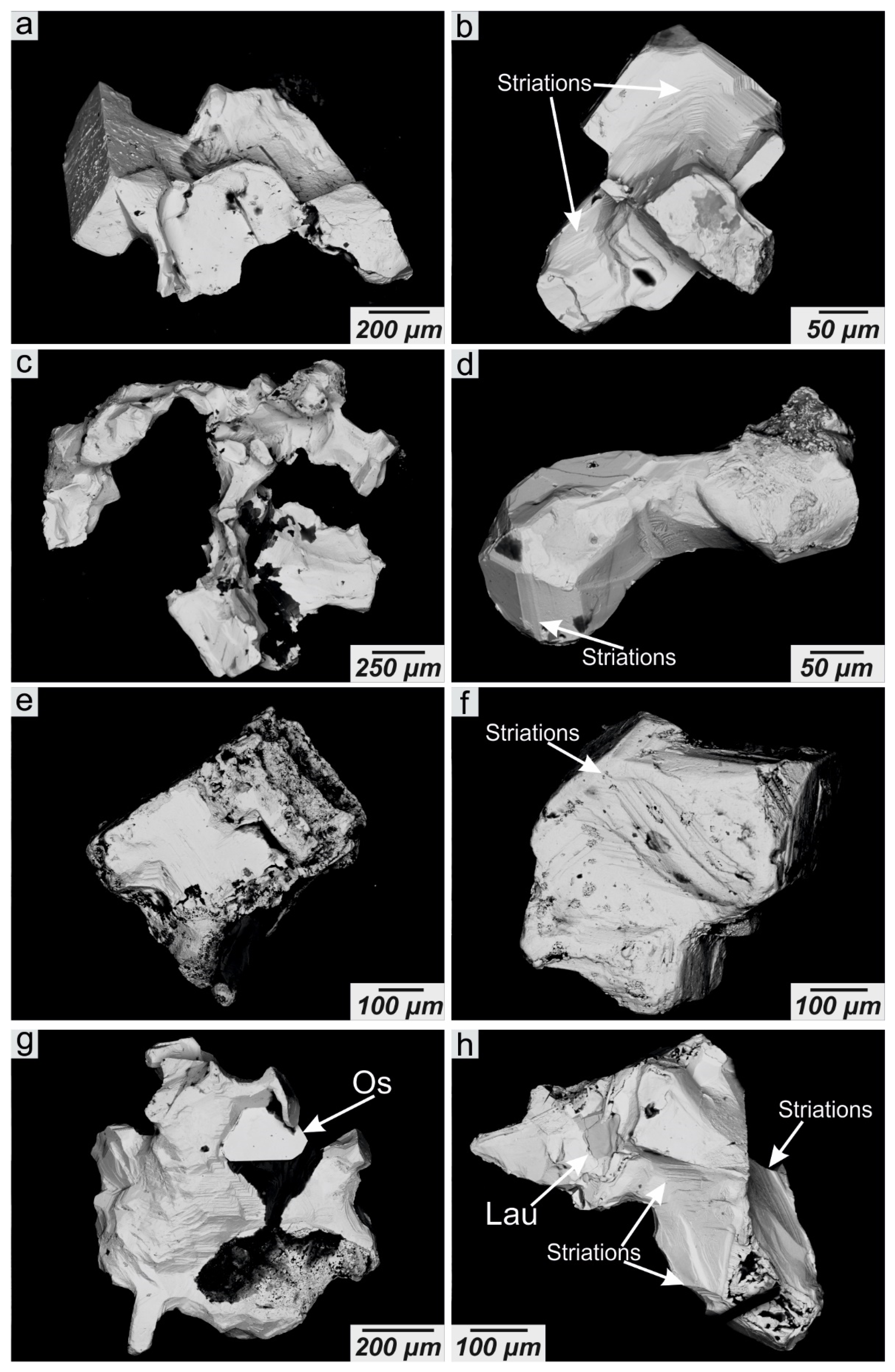
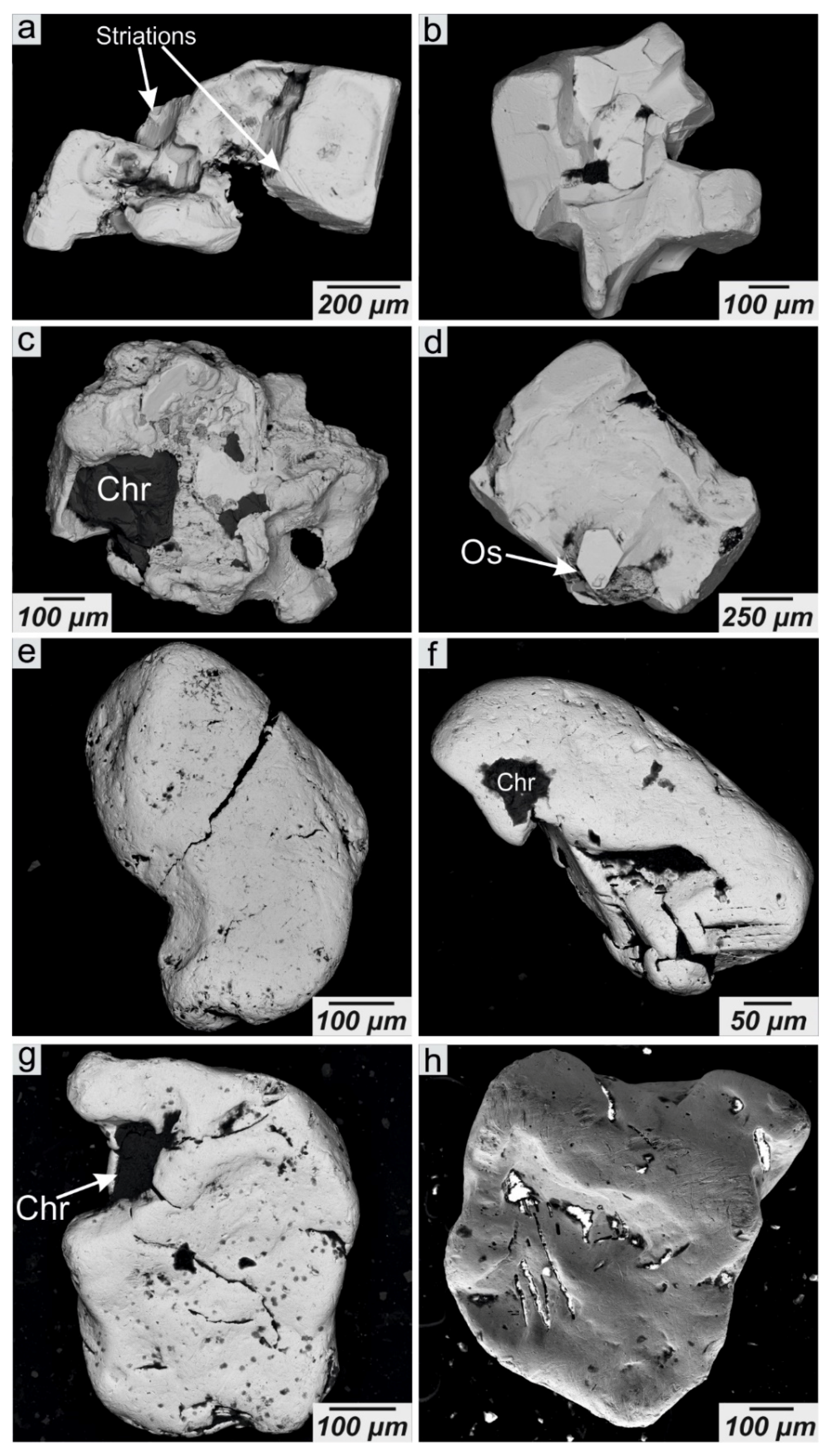
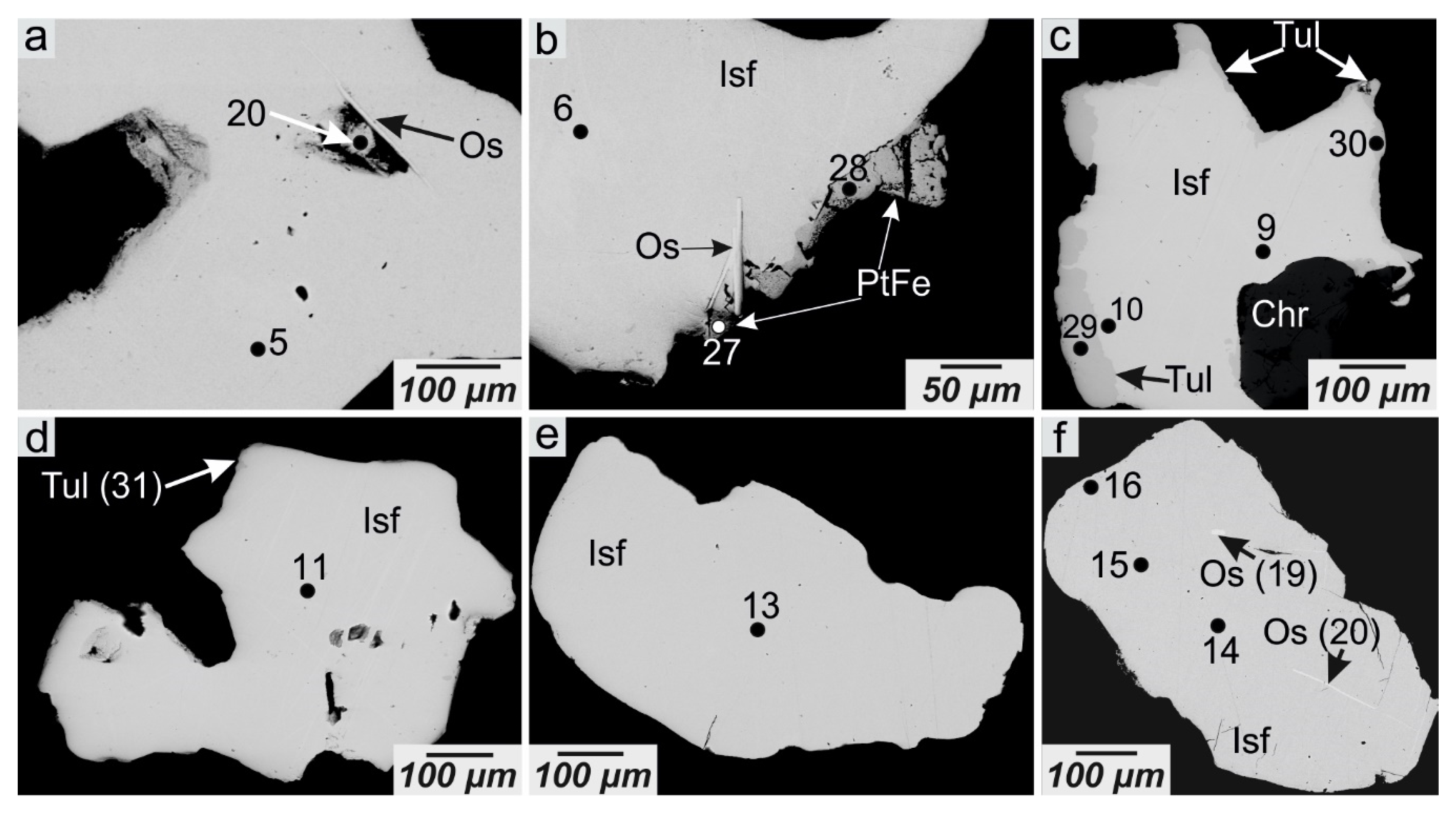
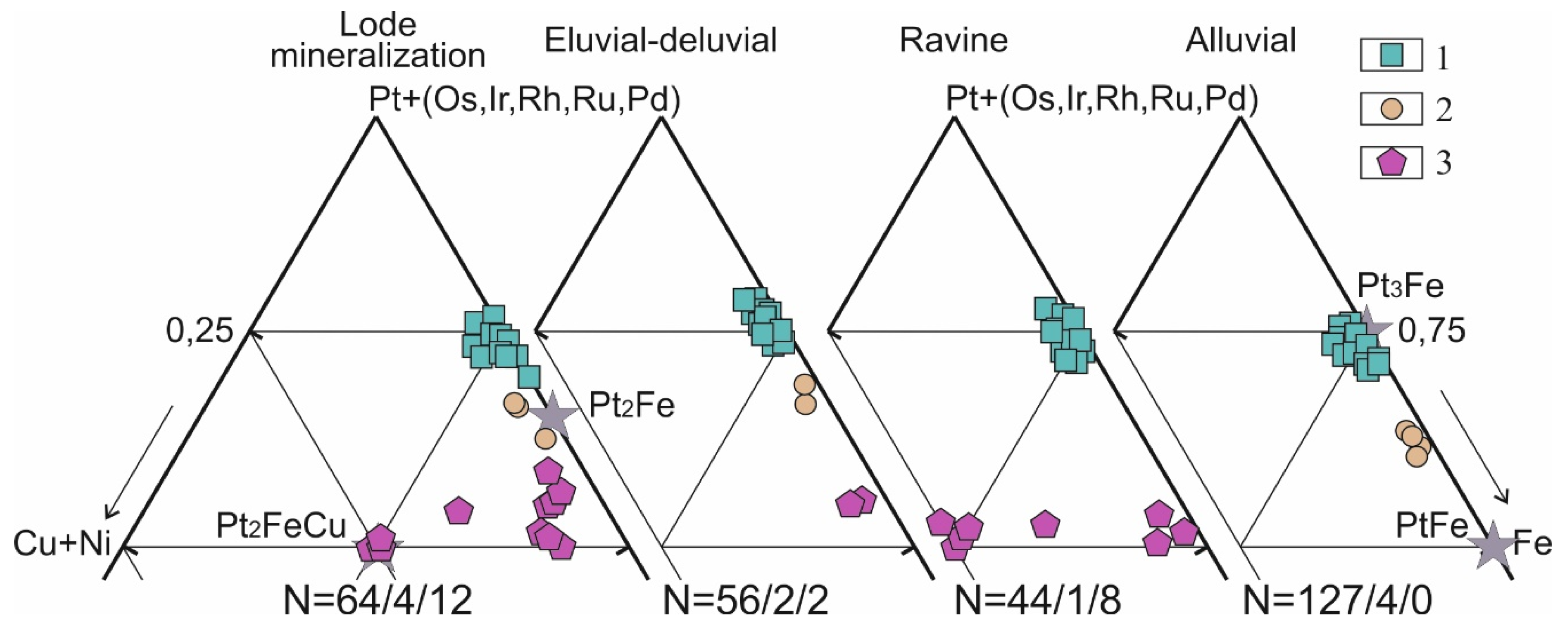
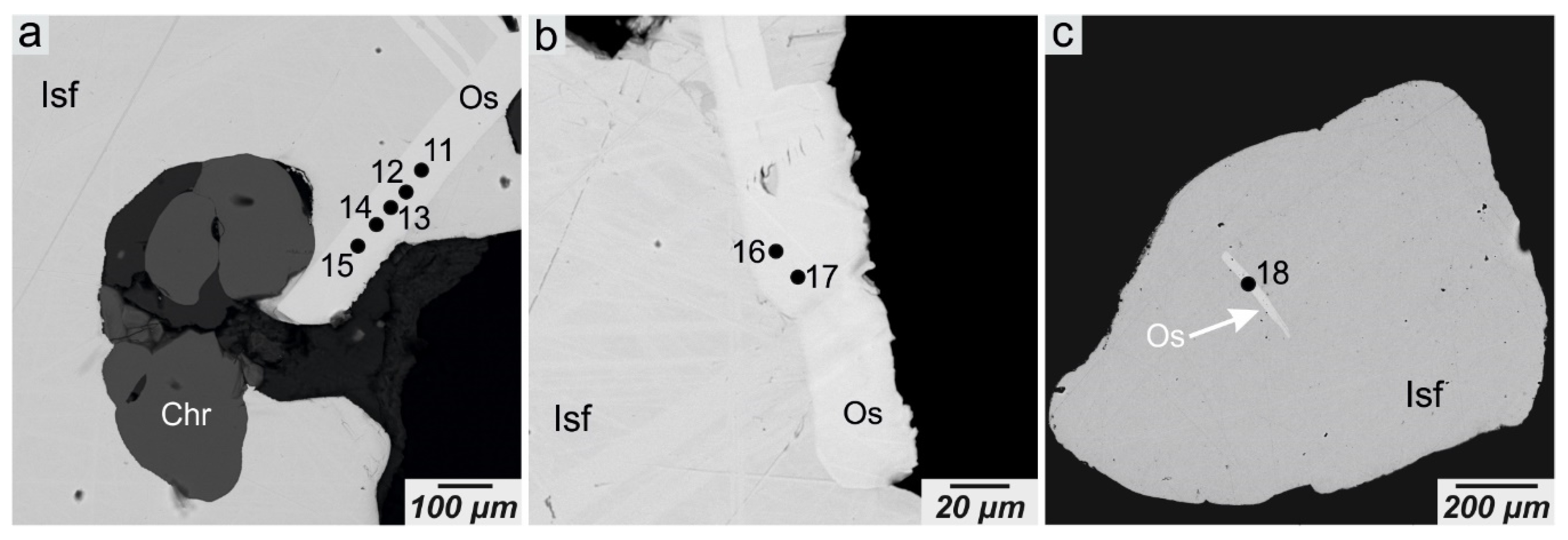
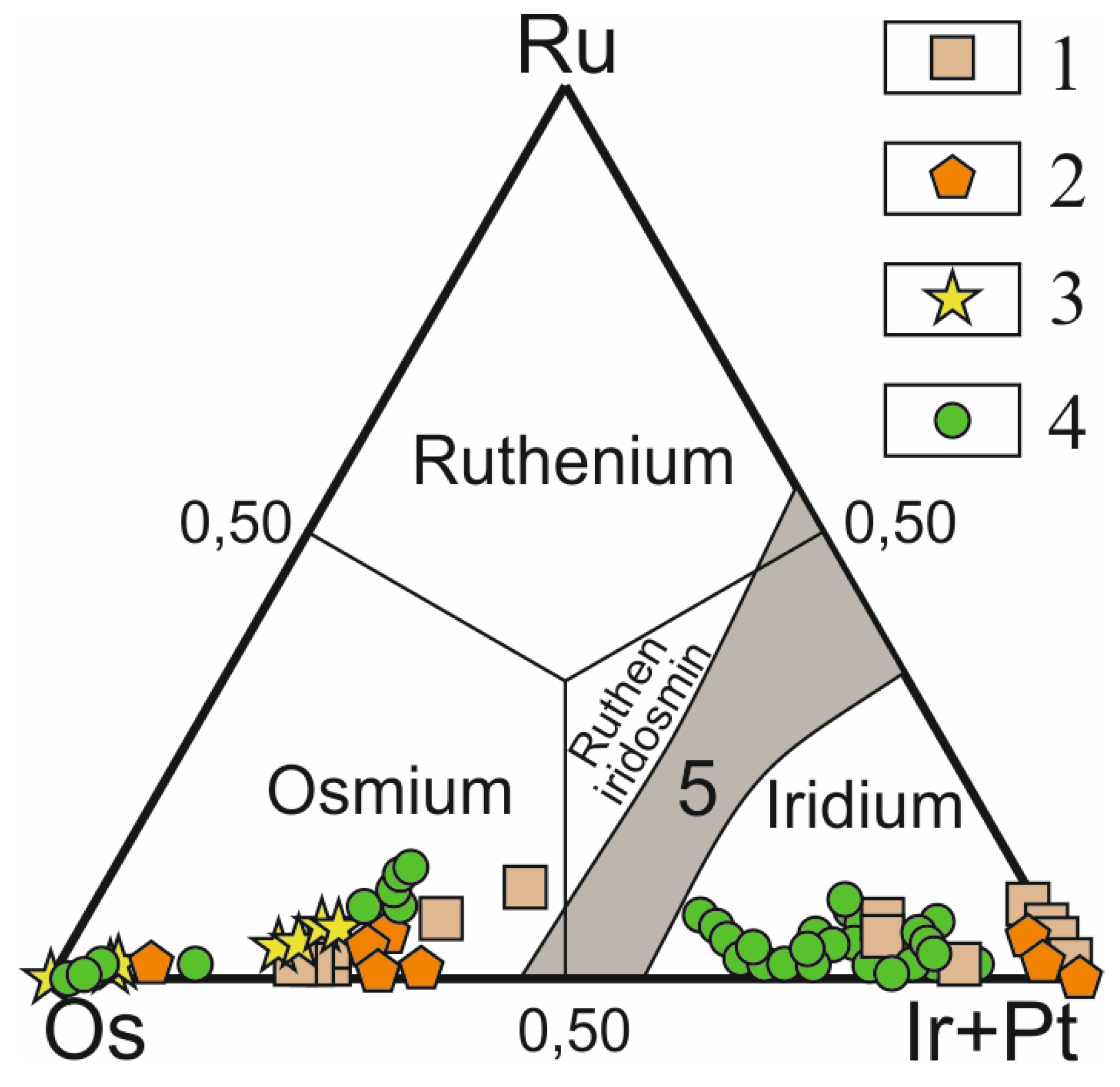
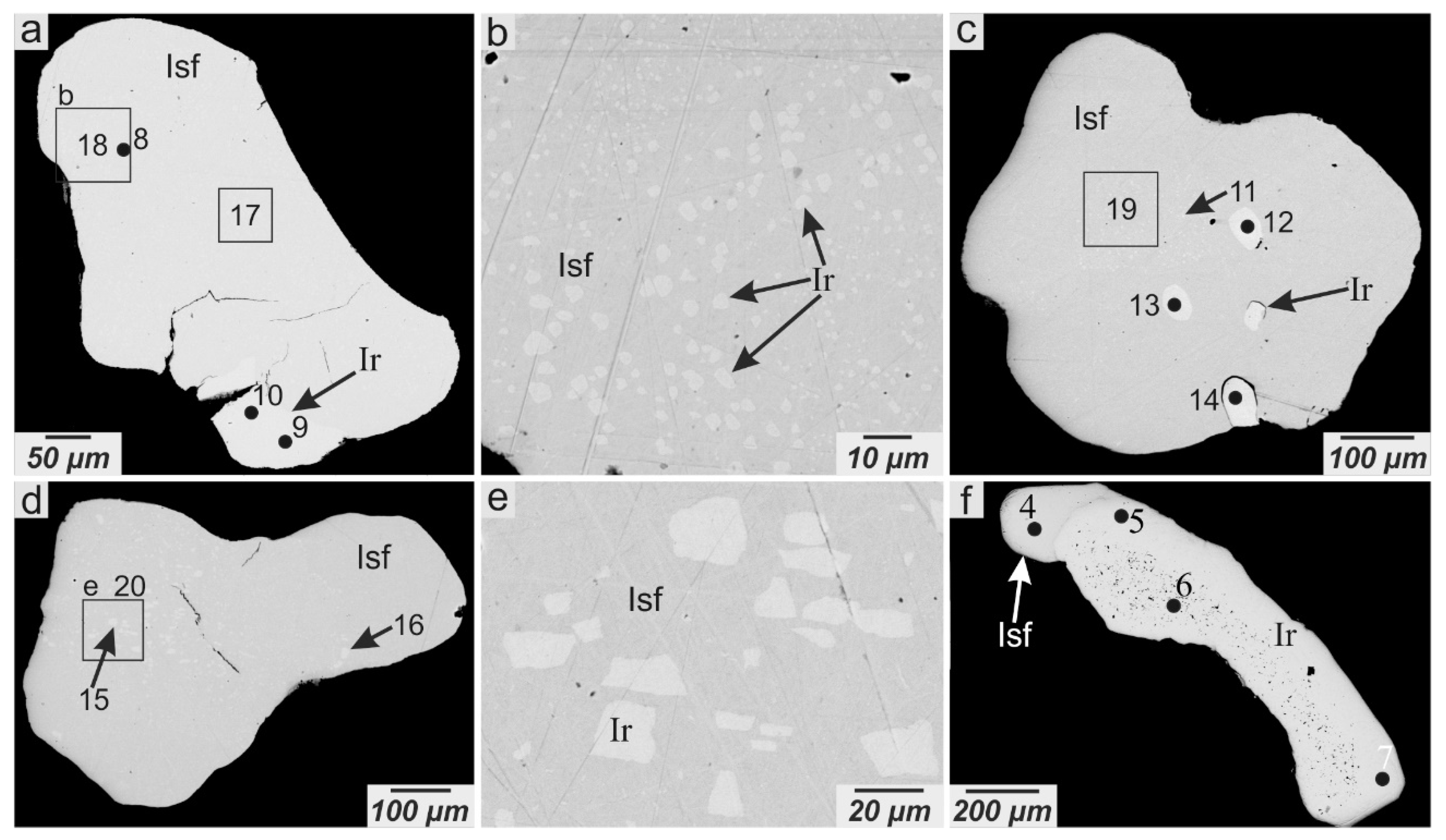
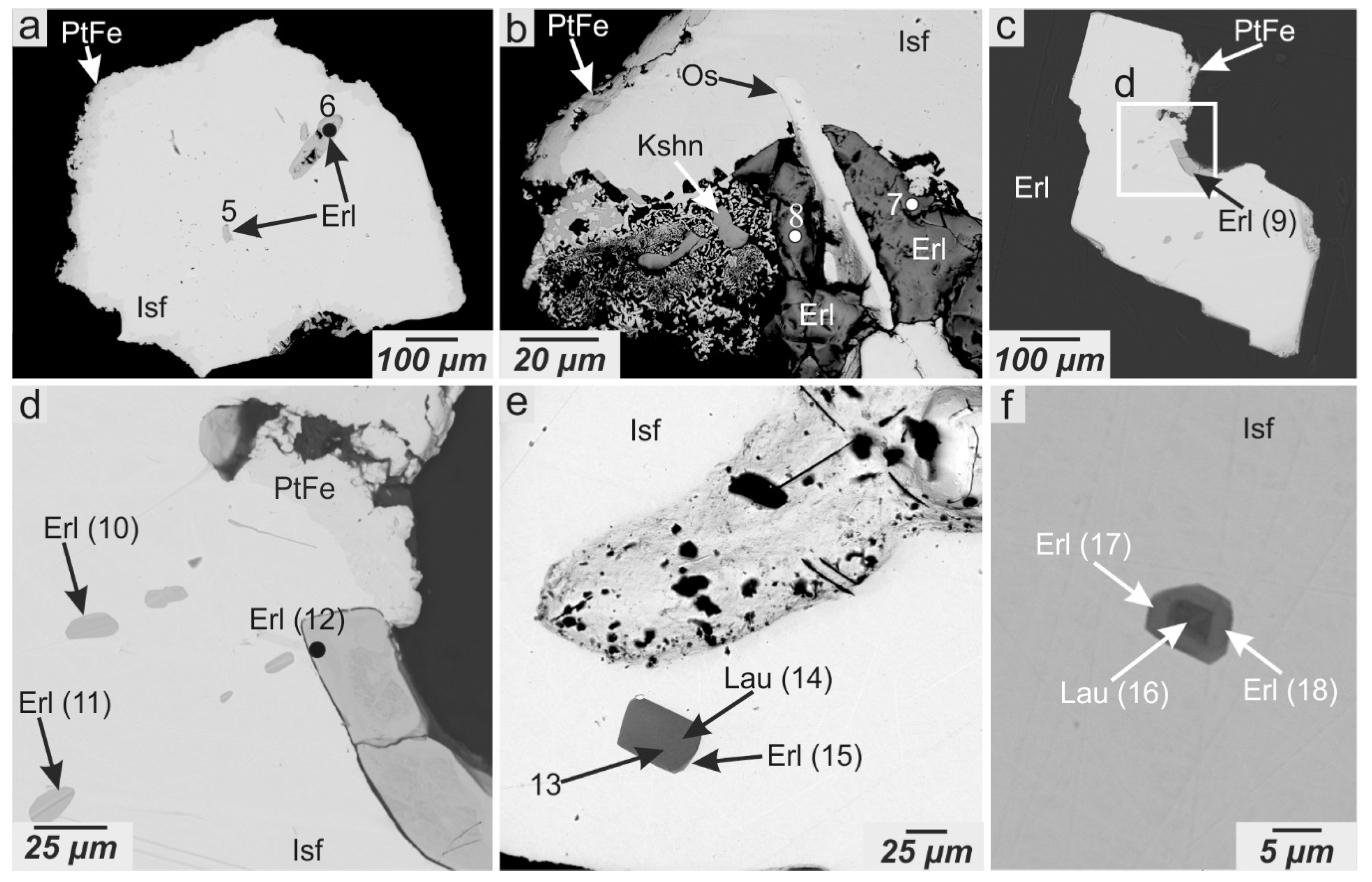
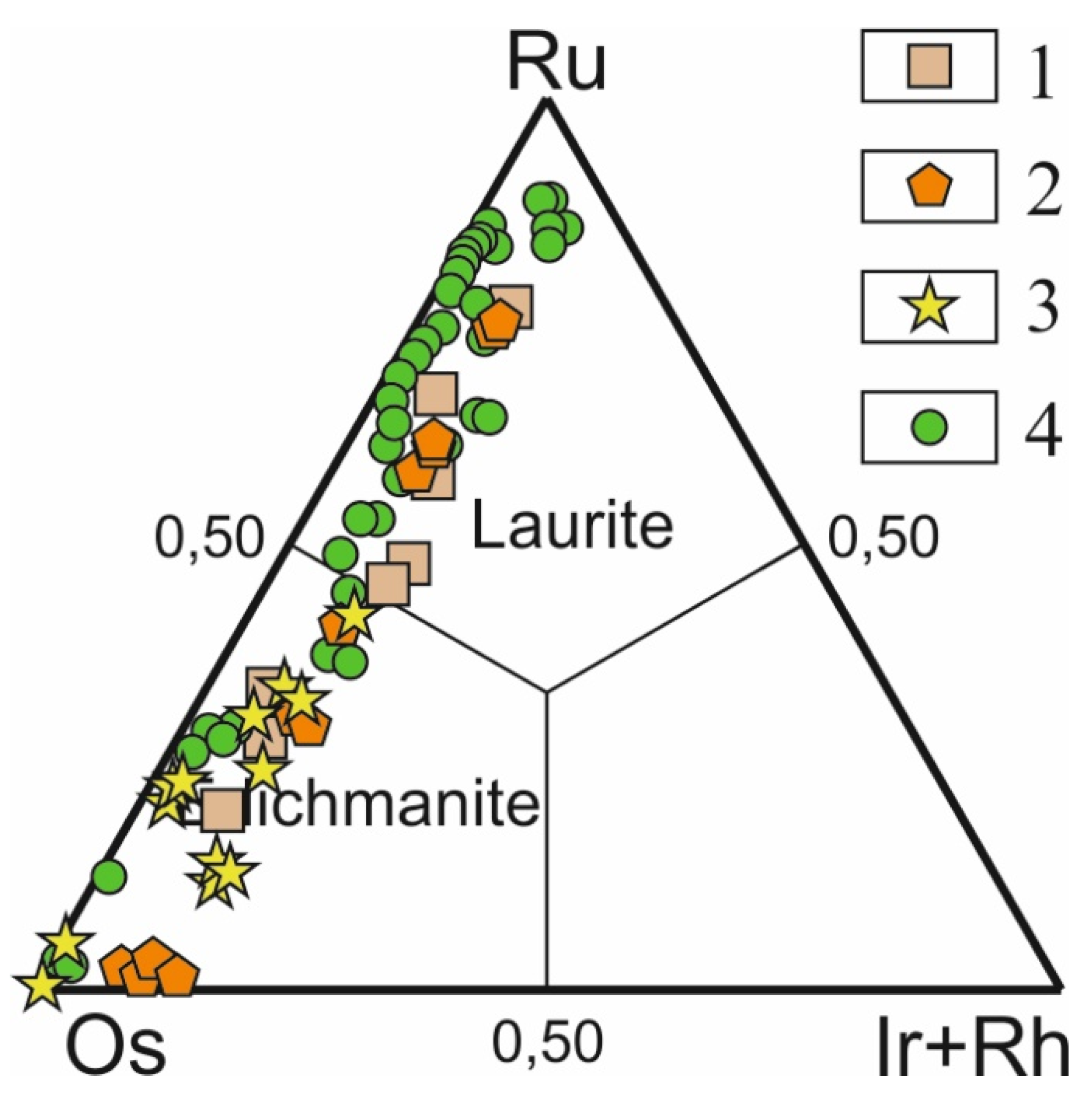
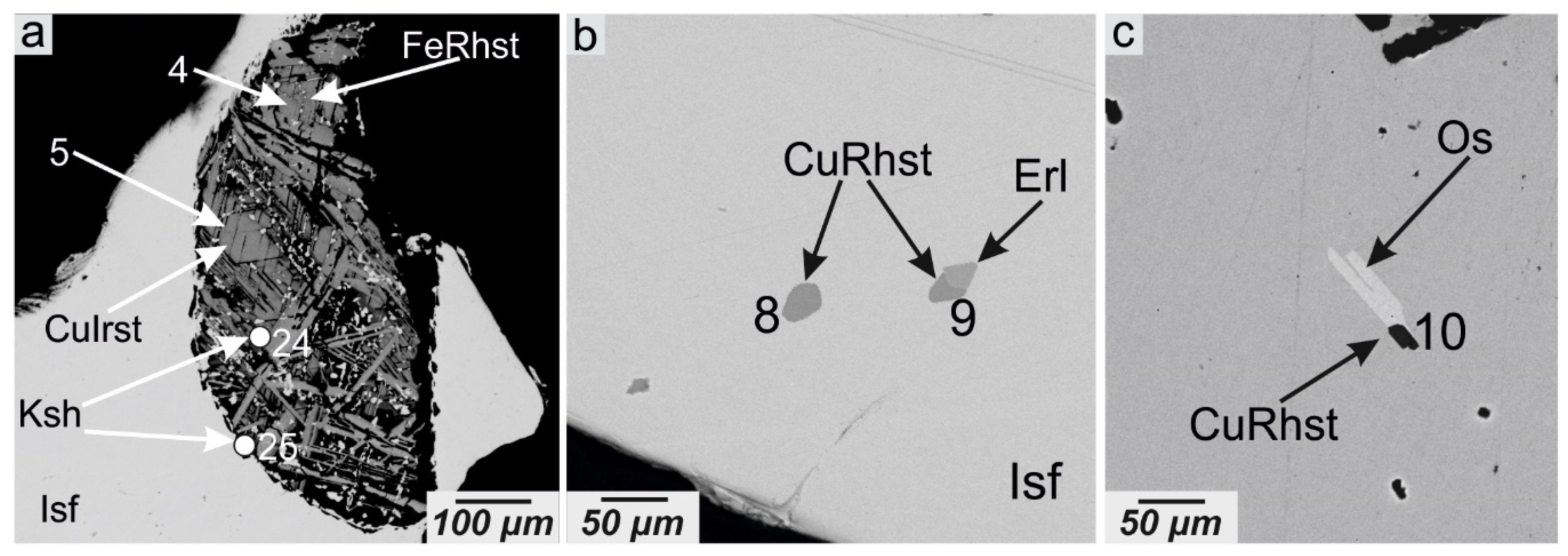
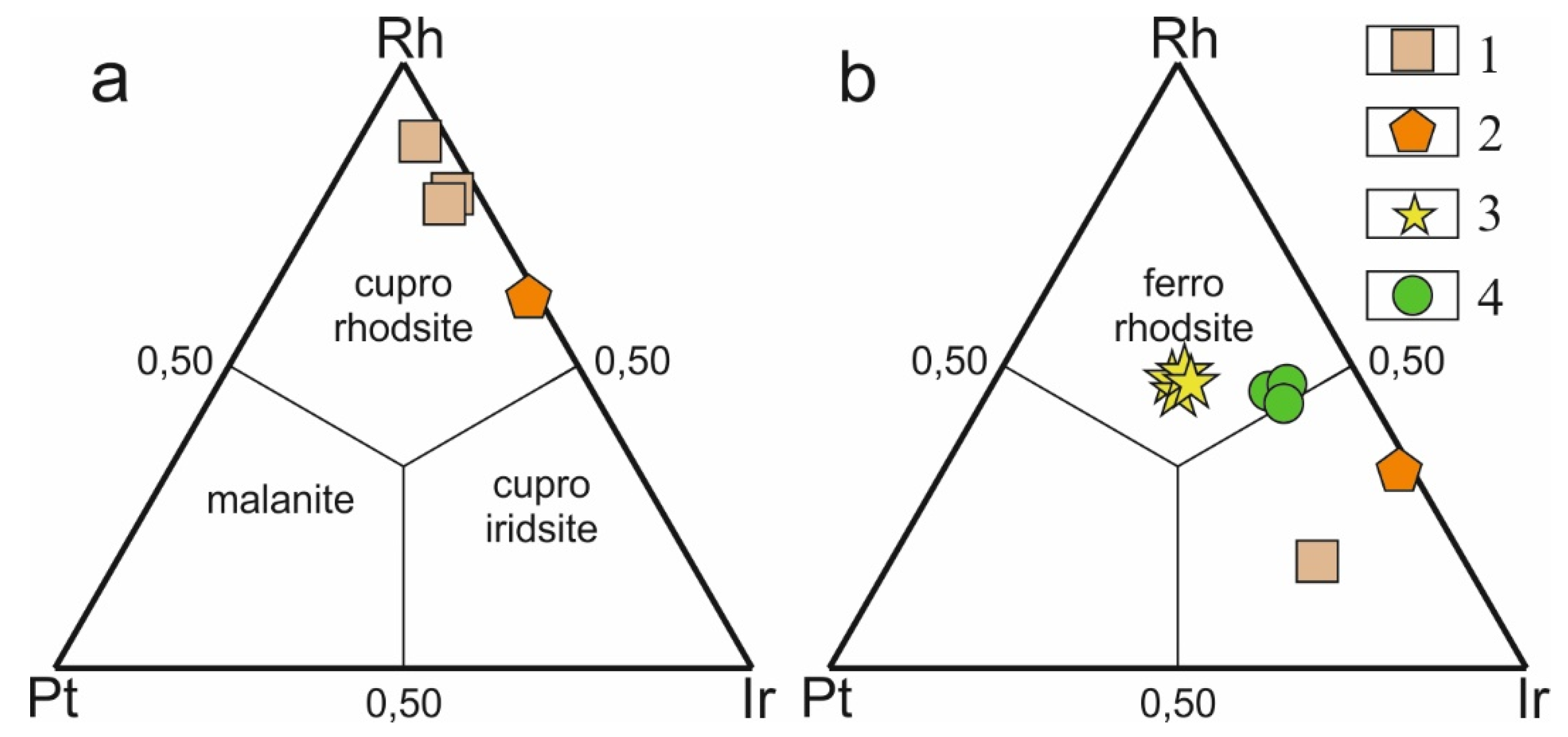

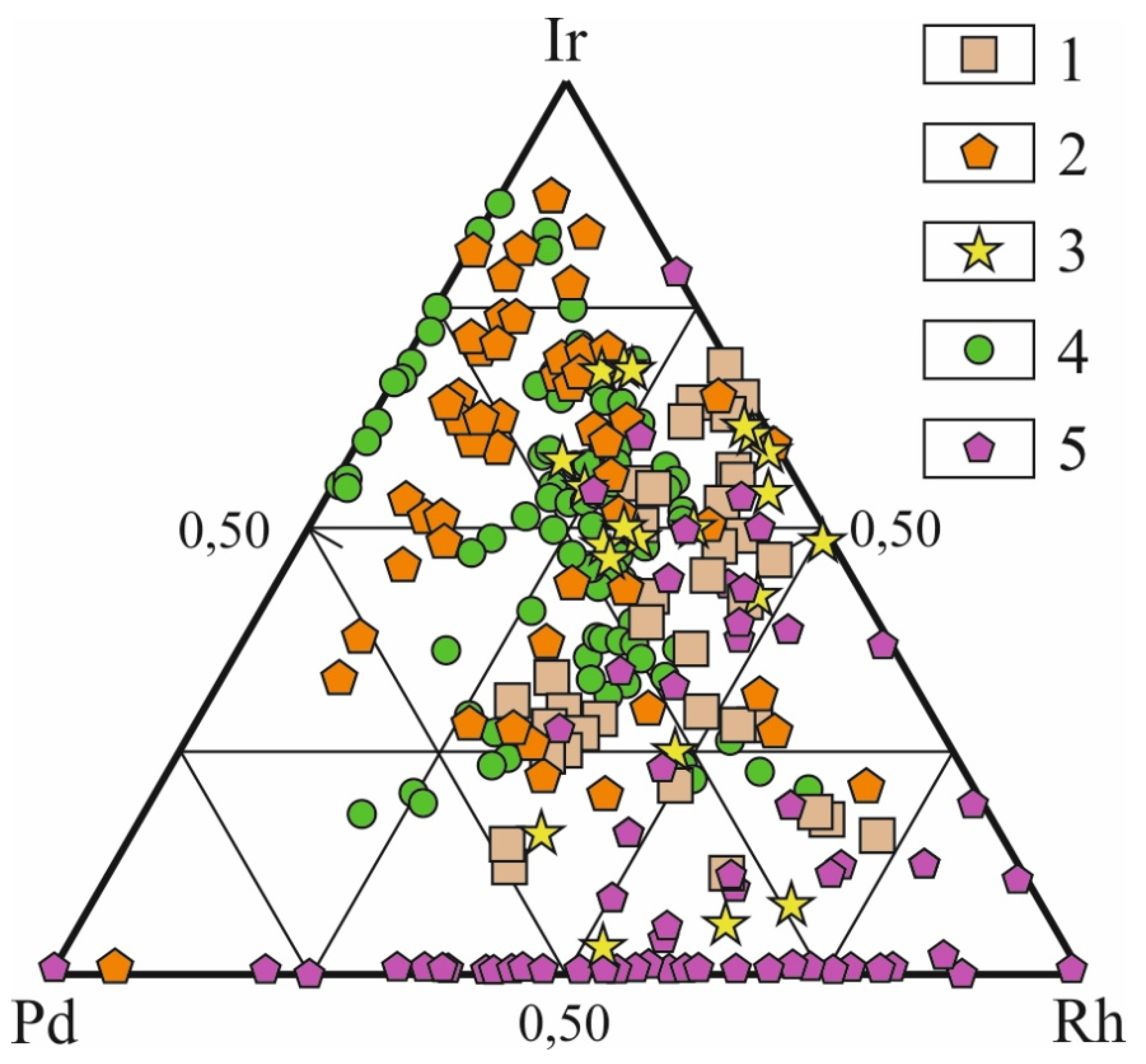
| No. | Fe | Ni | Cu | Ru | Rh | Pd | Ir | Pt | Total | No. | Fe | Ni | Cu | Ru | Rh | Pd | Ir | Pt |
|---|---|---|---|---|---|---|---|---|---|---|---|---|---|---|---|---|---|---|
| wt. % | at. % | |||||||||||||||||
| 1 | 7.85 | 0.13 | 0.86 | 0.12 | 1.03 | 0.26 | 0.51 | 88.67 | 99.43 | 1 | 22.43 | 0.35 | 2.16 | 0.19 | 1.60 | 0.39 | 0.42 | 72.46 |
| 2 | 8.72 | 0.13 | 0.84 | bdl | 0.73 | 0.54 | bdl | 88.76 | 99.72 | 2 | 24.46 | 0.35 | 2.07 | bdl | 1.11 | 0.79 | bdl | 71.22 |
| 3 | 8.73 | 0.02 | 0.51 | bdl | 0.67 | 0.77 | 1.03 | 87.22 | 98.95 | 3 | 24.79 | 0.05 | 1.27 | bdl | 1.03 | 1.15 | 0.85 | 70.86 |
| 4 | 7.89 | 0.07 | 0.87 | bdl | 1.24 | 0.18 | 3.44 | 85.90 | 99.59 | 4 | 22.51 | 0.19 | 2.18 | bdl | 1.92 | 0.27 | 2.85 | 70.08 |
| 5 | 7.83 | 0.09 | 0.73 | 0.02 | 0.83 | 1.03 | 1.18 | 89.07 | 100.78 | 5 | 22.13 | 0.24 | 1.81 | 0.03 | 1.27 | 1.53 | 0.97 | 72.02 |
| 6 | 7.41 | bdl | 1.03 | bdl | 0.17 | 0.47 | 1.95 | 89.58 | 100.61 | 6 | 21.27 | bdl | 2.60 | bdl | 0.26 | 0.71 | 1.62 | 73.54 |
| 7 | 7.70 | 0.06 | 0.70 | bdl | 0.54 | 0.58 | 4.60 | 86.42 | 100.60 | 7 | 21.99 | 0.17 | 1.76 | bdl | 0.83 | 0.87 | 3.81 | 70.57 |
| 8 | 7.47 | 0.02 | 0.75 | bdl | 0.59 | 0.57 | 7.52 | 83.45 | 100.37 | 8 | 21.46 | 0.05 | 1.89 | bdl | 0.92 | 0.86 | 6.27 | 68.55 |
| 9 | 7.84 | 0.09 | 0.59 | 0.24 | 0.85 | bdl | 1.60 | 89.51 | 100.72 | 9 | 22.33 | 0.24 | 1.48 | 0.38 | 1.31 | bdl | 1.32 | 72.94 |
| 10 | 7.84 | 0.04 | 0.63 | 0.56 | 0.88 | 0.41 | 1.85 | 88.50 | 100.71 | 10 | 22.22 | 0.11 | 1.57 | 0.88 | 1.35 | 0.61 | 1.52 | 71.74 |
| 11 | 8.56 | 0.37 | 0.84 | bdl | 0.73 | 0.11 | bdl | 90.08 | 100.69 | 11 | 23.87 | 0.98 | 2.06 | bdl | 1.10 | 0.16 | bdl | 71.83 |
| 12 | 8.19 | 0.05 | 0.10 | 0.20 | 1.02 | 0.56 | 0.15 | 90.64 | 100.91 | 12 | 23.23 | 0.13 | 0.25 | 0.31 | 1.57 | 0.83 | 0.12 | 73.56 |
| 13 | 8.80 | bdl | 0.44 | 0.21 | 0.49 | 0.47 | 5.07 | 84.01 | 99.49 | 13 | 24.94 | bdl | bdl | 1.14 | bdl | 0.06 | 4.67 | 69.19 |
| 14 | 8.55 | 0.25 | 0.62 | 0.31 | 1.13 | 0.84 | 3.93 | 83.48 | 99.11 | 14 | 24.03 | 0.67 | 1.53 | 0.48 | 1.72 | 1.24 | 3.21 | 67.12 |
| 15 | 8.64 | 0.66 | 1.16 | 0.24 | 0.87 | 0.38 | 4.06 | 83.88 | 99.89 | 15 | 23.83 | 1.73 | 2.81 | 0.37 | 1.30 | 0.55 | 3.25 | 66.16 |
| 16 | 8.62 | 0.19 | 0.69 | 0.11 | 0.39 | 0.29 | 5.15 | 83.56 | 99.00 | 16 | 24.47 | 0.51 | 1.72 | 0.17 | 0.60 | 0.43 | 4.24 | 67.86 |
| 17 | 8.27 | bdl | 0.41 | bdl | 0.50 | 0.80 | bdl | 90.58 | 100.56 | 17 | 23.48 | bdl | 1.02 | bdl | 0.77 | 1.19 | bdl | 73.54 |
| 18 | 13.59 | bdl | 1.03 | bdl | bdl | bdl | bdl | 84.16 | 98.78 | 18 | 35.24 | bdl | 2.35 | bdl | bdl | bdl | bdl | 62.41 |
| 19 | 11.54 | bdl | 1.26 | bdl | bdl | bdl | bdl | 88.13 | 100.93 | 19 | 30.49 | bdl | 2.91 | bdl | bdl | bdl | bdl | 66.60 |
| 20 | 11.63 | bdl | 1.09 | 0.05 | 0.92 | bdl | 1.26 | 85.82 | 100.77 | 20 | 30.58 | bdl | 2.52 | 0.07 | 1.32 | bdl | 0.96 | 64.55 |
| 21 | 14.60 | 0.51 | 0.82 | bdl | 0.80 | 0.44 | 6.00 | 76.25 | 99.42 | 21 | 36.48 | 1.21 | 1.80 | bdl | 1.08 | 0.58 | 4.35 | 54.50 |
| 22 | 13.36 | 0.56 | 0.27 | bdl | 0.37 | 0.47 | 6.10 | 78.25 | 99.38 | 22 | 34.50 | 1.37 | 0.61 | bdl | 0.52 | 0.64 | 4.57 | 57.79 |
| No. | Fe | Ni | Cu | Ru | Rh | Pd | Ir | Pt | Total | No. | Fe | Ni | Cu | Ru | Rh | Pd | Ir | Pt |
|---|---|---|---|---|---|---|---|---|---|---|---|---|---|---|---|---|---|---|
| wt. % | at. % | |||||||||||||||||
| 23 | 10.66 | bdl | 13.23 | bdl | bdl | bdl | bdl | 76.11 | 100.00 | 23 | 24.20 | bdl | 26.38 | bdl | bdl | bdl | bdl | 49.42 |
| 24 | 18.90 | bdl | 3.26 | bdl | bdl | bdl | bdl | 77.41 | 99.57 | 24 | 43.04 | bdl | 6.52 | bdl | bdl | bdl | bdl | 50.44 |
| 25 | 16.28 | bdl | 2.72 | bdl | bdl | bdl | bdl | 80.35 | 99.35 | 25 | 39.09 | bdl | 5.73 | bdl | bdl | bdl | bdl | 55.18 |
| 26 | 14.93 | bdl | 1.67 | bdl | bdl | bdl | bdl | 82.26 | 98.86 | 26 | 37.40 | bdl | 3.67 | bdl | bdl | bdl | bdl | 58.93 |
| 27 | 17.44 | 0.09 | 1.18 | bdl | 0.02 | 0.31 | 0.39 | 79.53 | 98.96 | 27 | 41.92 | 0.21 | 2.49 | bdl | 0.03 | 0.39 | 0.27 | 54.69 |
| 28 | 16.78 | 0.10 | 2.30 | bdl | 0.34 | 1.71 | 0.06 | 77.78 | 99.07 | 28 | 39.72 | 0.23 | 4.78 | bdl | 0.44 | 2.12 | 0.04 | 52.67 |
| 29 | 8.75 | 0.23 | 13.28 | bdl | 0.38 | 0.09 | 2.86 | 75.08 | 100.67 | 29 | 20.26 | 0.51 | 27.00 | bdl | 0.48 | 0.11 | 1.92 | 49.72 |
| 30 | 9.31 | 0.22 | 12.44 | 0.49 | 1.05 | 0.14 | 2.52 | 73.71 | 99.88 | 30 | 21.57 | 0.48 | 25.31 | 0.63 | 1.32 | 0.17 | 1.69 | 48.83 |
| 31 | 10.61 | 0.27 | 11.80 | 0.15 | 0.41 | 0.36 | bdl | 76.84 | 100.44 | 31 | 24.28 | 0.59 | 23.71 | 0.19 | 0.51 | 0.43 | bdl | 50.29 |
| 32 | 18.17 | 0.30 | 1.19 | 0.41 | bdl | 0.06 | bdl | 78.96 | 99.09 | 32 | 42.91 | 0.67 | 2.47 | 0.53 | bdl | 0.07 | bdl | 53.35 |
| No. | Ru | Rh | Pd | Os | Ir | Pt | Total | No. | Ru | Rh | Pd | Os | Ir | Pt |
|---|---|---|---|---|---|---|---|---|---|---|---|---|---|---|
| wt. % | at. % | |||||||||||||
| 1 | 6.20 | bdl | bdl | 50.59 | 43.21 | bdl | 100.0 | 1 | 11.11 | bdl | bdl | 48.18 | 40.71 | bdl |
| 2 | 0.95 | bdl | bdl | 68.10 | 30.93 | bdl | 99.98 | 2 | 1.78 | bdl | bdl | 67.77 | 30.45 | bdl |
| 3 | 1.65 | bdl | bdl | 72.02 | 26.28 | bdl | 99.95 | 3 | 3.07 | bdl | bdl | 71.22 | 25.71 | bdl |
| 4 | 1.05 | bdl | bdl | 73.68 | 25.27 | bdl | 100.0 | 4 | 1.96 | bdl | bdl | 73.20 | 24.84 | bdl |
| 5 | 1.34 | bdl | bdl | 74.87 | 23.78 | bdl | 99.99 | 5 | 2.50 | bdl | bdl | 74.18 | 23.32 | bdl |
| 6 | 0.14 | 0.34 | bdl | 62.54 | 34.73 | 1.10 | 98.85 | 6 | 0.26 | 0.63 | bdl | 63.27 | 34.76 | 1.08 |
| 7 | 0.17 | 0.68 | bdl | 67.41 | 30.86 | 0.55 | 99.67 | 7 | 0.33 | 1.26 | bdl | 67.36 | 30.51 | 0.54 |
| 8 | 0.55 | 0.21 | 0.16 | 67.84 | 29.79 | 0.19 | 98.74 | 8 | 1.04 | 0.38 | 0.29 | 68.39 | 29.72 | 0.18 |
| 9 | 2.43 | 0.16 | 0.20 | 68.36 | 28.90 | 1.14 | 101.19 | 9 | 4.44 | 0.28 | 0.34 | 66.17 | 27.69 | 1.08 |
| 10 | 0.83 | 0.46 | bdl | 89.91 | 6.57 | 2.79 | 100.56 | 10 | 1.54 | 0.83 | bdl | 88.55 | 6.40 | 2.68 |
| 11 | 0.71 | 0.32 | bdl | 93.29 | 5.23 | bdl | 99.55 | 11 | 1.33 | 0.59 | bdl | 92.93 | 5.15 | bdl |
| 12 | 0.68 | 0.48 | bdl | 93.1 | 4.66 | bdl | 98.92 | 12 | 1.28 | 0.89 | bdl | 93.21 | 4.62 | bdl |
| 13 | 0.71 | 0.34 | bdl | 92.73 | 4.87 | bdl | 98.65 | 13 | 1.34 | 0.63 | bdl | 93.19 | 4.84 | bdl |
| 14 | 0.87 | 0.34 | bdl | 92.74 | 5.23 | bdl | 99.18 | 14 | 1.63 | 0.63 | bdl | 92.57 | 5.17 | bdl |
| 15 | 1.01 | 0.41 | bdl | 92.72 | 4.88 | bdl | 99.02 | 15 | 1.90 | 0.76 | bdl | 92.52 | 4.82 | bdl |
| 16 | 2.04 | 0.89 | bdl | 76.05 | 21.34 | bdl | 100.32 | 16 | 3.74 | 1.61 | bdl | 74.08 | 20.57 | bdl |
| 17 | 2.18 | 0.65 | bdl | 75.47 | 22.07 | bdl | 100.37 | 17 | 4.00 | 1.17 | bdl | 73.55 | 21.28 | bdl |
| 18 | 1.05 | 0.69 | bdl | 93.26 | 4.29 | bdl | 99.29 | 18 | 1.95 | 1.26 | bdl | 92.58 | 4.21 | bdl |
| 19 | 6.97 | 0.30 | 0.60 | 60.54 | 30.40 | 0.39 | 99.19 | 19 | 12.40 | 0.52 | 1.01 | 57.26 | 28.45 | 0.36 |
| 20 | 8.58 | 0.55 | bdl | 59.10 | 28.96 | 2.82 | 100.02 | 20 | 15.00 | 0.95 | bdl | 54.88 | 26.62 | 2.55 |
| No. | Fe | Ni | Cu | Ru | Rh | Pd | Os | Ir | Pt | Total | No. | Fe | Ni | Cu | Ru | Rh | Pd | Os | Ir | Pt |
|---|---|---|---|---|---|---|---|---|---|---|---|---|---|---|---|---|---|---|---|---|
| wt. % | at. % | |||||||||||||||||||
| 1 | 11.09 | bdl | bdl | bdl | 1.41 | bdl | bdl | 72.58 | 14.72 | 99.80 | 1 | 29.87 | bdl | bdl | bdl | 2.06 | bdl | bdl | 56.73 | 11.34 |
| 2 | 1.96 | bdl | bdl | 4.60 | 3.83 | bdl | bdl | 79.03 | 10.59 | 100.01 | 2 | 6.02 | bdl | bdl | 7.80 | 6.38 | bdl | bdl | 70.49 | 9.31 |
| 3 | 0.43 | bdl | bdl | 2.64 | 1.53 | bdl | 23.49 | 66.27 | 5.64 | 100.00 | 3 | 1.41 | bdl | bdl | 4.79 | 2.72 | bdl | 22.62 | 63.16 | 5.30 |
| 4 | 10.31 | 0.56 | 0.23 | bdl | 1.08 | 0.64 | bdl | 15.95 | 71.66 | 100.43 | 4 | 27.79 | 1.45 | 0.54 | bdl | 1.58 | 0.91 | bdl | 12.48 | 55.25 |
| 5 | 2.86 | 0.18 | bdl | 2.71 | 2.42 | 0.82 | 2.83 | 79.63 | 8.75 | 100.20 | 5 | 8.74 | 0.52 | bdl | 4.58 | 4.00 | 1.32 | 2.54 | 70.65 | 7.65 |
| 6 | 2.52 | 0.15 | bdl | 2.38 | 2.02 | 0.69 | 1.82 | 73.68 | 16.82 | 100.08 | 6 | 7.85 | 0.44 | bdl | 4.08 | 3.41 | 1.13 | 1.66 | 66.47 | 14.96 |
| 7 | 2.72 | 0.14 | bdl | 1.22 | 1.73 | 0.68 | 2.93 | 73.08 | 17.35 | 99.85 | 7 | 8.55 | 0.41 | bdl | 2.11 | 2.94 | 1.12 | 2.70 | 66.59 | 15.58 |
| 8 | 0.74 | bdl | 0.14 | 3.43 | 3.50 | bdl | 15.53 | 68.37 | 8.18 | 99.89 | 8 | 2.36 | bdl | 0.40 | 6.03 | 6.05 | bdl | 14.51 | 63.20 | 7.45 |
| 9 | 1.42 | 0.16 | 0.72 | 2.55 | 2.52 | bdl | 18.71 | 57.56 | 15.64 | 99.28 | 9 | 4.49 | 0.48 | 2.00 | 4.46 | 4.32 | bdl | 17.34 | 52.75 | 14.13 |
| 10 | 1.04 | bdl | bdl | 2.76 | 2.14 | 0.87 | 22.01 | 62.78 | 7.99 | 99.59 | 10 | 3.34 | bdl | bdl | 4.88 | 3.73 | 1.47 | 20.73 | 58.52 | 7.33 |
| 11 | 0.55 | bdl | bdl | 2.62 | 2.79 | 0.10 | 16.70 | 70.19 | 7.03 | 99.98 | 11 | 1.77 | bdl | bdl | 4.68 | 4.91 | 0.18 | 15.88 | 66.06 | 6.52 |
| 12 | 0.35 | 0.06 | bdl | 3.37 | 2.20 | bdl | 21.91 | 59.09 | 12.26 | 99.24 | 12 | 1.15 | 0.19 | bdl | 6.09 | 3.91 | bdl | 21.04 | 56.14 | 11.48 |
| 13 | 0.39 | 0.36 | 0.28 | 3.90 | 1.35 | bdl | 18.83 | 62.07 | 12.02 | 99.20 | 13 | 1.27 | 1.11 | 0.79 | 6.99 | 2.37 | bdl | 17.91 | 58.41 | 11.15 |
| 14 | 0.14 | 0.17 | 0.20 | 3.79 | 2.08 | 0.08 | 13.75 | 68.90 | 11.11 | 100.22 | 14 | 0.45 | 0.52 | 0.57 | 6.76 | 3.64 | 0.14 | 13.03 | 64.62 | 10.27 |
| 15 | 0.39 | 0.07 | 0.25 | 2.82 | 2.23 | 0.17 | 20.23 | 65.74 | 7.58 | 99.48 | 15 | 1.26 | 0.22 | 0.73 | 5.07 | 3.94 | 0.30 | 19.32 | 62.10 | 7.06 |
| 16 | 0.53 | bdl | 0.15 | 1.30 | 3.53 | bdl | 12.93 | 71.32 | 9.74 | 99.50 | 16 | 1.73 | bdl | 0.44 | 2.35 | 6.26 | bdl | 12.40 | 67.71 | 9.11 |
| Field | ||||||||||||||||||||
| 17 | 7.67 | 0.30 | 0.70 | bdl | 0.94 | 0.71 | bdl | 14.42 | 80.76 | 105.50 | 17 | 20.88 | 0.78 | 1.67 | bdl | 1.39 | 1.01 | bdl | 11.39 | 62.88 |
| 18 | 8.21 | 0.03 | 0.72 | 0.25 | 1.14 | 0.32 | bdl | 13.27 | 77.33 | 101.27 | 18 | 22.96 | 0.08 | 1.77 | 0.39 | 1.73 | 0.47 | bdl | 10.77 | 61.83 |
| 19 | 7.88 | bdl | 1.12 | 0.24 | 0.39 | 0.44 | bdl | 10.14 | 82.77 | 102.98 | 19 | 21.85 | bdl | 2.73 | 0.37 | 0.59 | 0.64 | bdl | 8.16 | 65.66 |
| 20 | 7.16 | 0.15 | 0.23 | 0.30 | 0.54 | 0.05 | bdl | 15.99 | 74.29 | 98.71 | 20 | 21.13 | 0.42 | 0.60 | 0.49 | 0.86 | 0.08 | bdl | 13.70 | 62.72 |
| No. | S | Ru | Rh | Pd | Os | Ir | Total | Calculated Mineral Formulae |
|---|---|---|---|---|---|---|---|---|
| Laurite-Erlichmanite | ||||||||
| 1 | 25.61 | 8.86 | bdl | bdl | 59.60 | 6.30 | 100.37 | (Os0.77Ru0.21Ir0.08)1.06S1.94 |
| 2 | 28.00 | 14.06 | bdl | bdl | 50.56 | 6.09 | 98.71 | (Os0.61Ru0.32Ir0.07)1.00S2.00 |
| 3 | 31.38 | 22.79 | 2.09 | bdl | 36.64 | 6.26 | 99.16 | (Ru0.46Os0.40 Ir0.07Rh0.04)0.97S2.03 |
| 4 | 33.15 | 28.65 | 1.71 | bdl | 30.05 | 5.54 | 99.10 | (Ru0.56Os0.31Ir0.06Rh0.03)0.96S2.04 |
| 5 | 25.94 | 0.79 | 2.85 | bdl | 64.95 | 4.60 | 99.13 | (Os0.84Ru0.02Rh0.07Ir0.06)0.99S2.01 |
| 6 | 27.03 | 0.85 | 2.66 | bdl | 66.11 | 2.36 | 99.01 | (Os0.85Ru0.02Rh0.06Ir0.03)0.96S2.04 |
| 7 | 31.37 | 18.88 | 1.32 | bdl | 42.15 | 6.15 | 99.87 | (Os0.46Ru0.39Ir0.07Rh0.03)0.95S2.05 |
| 8 | 29.05 | 13.63 | 1.90 | bdl | 49.38 | 5.93 | 99.89 | (Os0.58Ru0.30Ir0.07Rh0.04)0.99S2.01 |
| 9 | 29.26 | 15.25 | 2.31 | bdl | 50.16 | 2.14 | 99.12 | (Os0.59Ru0.33Rh0.05Ir0.02)0.99S2.01 |
| 10 | 29.40 | 12.95 | 1.91 | 0.47 | 52.48 | 1.97 | 99.18 | (Os0.62Ru0.28Rh0.04Ir0.02Pd0.01)0.97S2.03 |
| 11 | 27.77 | 12.23 | 1.91 | bdl | 54.79 | 4.65 | 101.35 | (Os0.65Ru0.28Ir0.06Rh0.04)1.03S1.97 |
| 12 | 29.26 | 20.33 | 2.51 | bdl | 43.25 | 4.98 | 100.33 | (Os0.49Ru0.43Ir0.06Rh0.05)1.03S1.97 |
| 13 | 37.43 | 51.82 | 1.38 | bdl | 5.91 | 4.36 | 100.90 | (Ru0.88Os0.06Ir0.04Rh0.02)1.00S2.00 |
| 14 | 38.15 | 50.88 | 1.06 | bdl | 6.96 | 3.87 | 100.92 | (Ru0.86Os0.06Ir0.03Rh0.02)0.97S2.03 |
| 15 | 32.27 | 28.97 | 1.64 | bdl | 33.51 | 4.19 | 100.58 | (Ru0.58Os0.35Ir0.04Rh0.03)1.00S2.00 |
| 16 | 36.02 | 47.71 | 2.53 | 0.72 | 8.88 | 4.89 | 100.75 | (Ru0.84Os0.09Ir0.04Rh0.04Pd0.01)1.02S1.98 |
| 17 | 31.57 | 33.72 | 2.46 | 0.54 | 24.13 | 6.60 | 99.02 | (Ru0.66Os0.25Ir0.07Rh0.05Pd0.01)1.04S1.96 |
| 18 | 32.60 | 33.51 | 2.90 | 0.38 | 23.72 | 6.46 | 99.57 | (Ru0.65Os0.24Ir0.07Rh0.05Pd0.01)1.02S1.98 |
| 19 | 29.36 | 17.63 | 1.95 | bdl | 45.78 | 5.80 | 100.52 | (Os0.52Ru0.38Ir0.07Rh0.04)1.01S1.99 |
| Kashinite-Bowieite | ||||||||
| 20 | 22.13 | bdl | 8.21 | bdl | bdl | 70.12 | 100.46 | (Ir1.61Rh0.35)1.96 S3.04 |
| 21 | 23.53 | bdl | 15.34 | bdl | bdl | 61.34 | 100.21 | (Ir1.33Rh0.62)1.95 S3.05 |
| 22 | 25.35 | bdl | 22.42 | bdl | bdl | 51.88 | 99.65 | (Ir1.06Rh0.85)1.91 S3.09 |
| 23 | 26.49 | 0.14 | 30.95 | bdl | bdl | 41.46 | 99.04 | (Rh1.12Ir0.80Ru0.01)1.93 S3.07 |
| 24 | 23.70 | bdl | 21.04 | bdl | bdl | 55.10 | 99.84 | (Ir1.17Rh0.83)2.00 S3.00 |
| 25 | 24.09 | bdl | 22.60 | bdl | bdl | 53.58 | 100.27 | (Ir1.12Rh0.87)1.99 S3.01 |
| No. | S | Fe | Cu | Rh | Ir | Pt | Total | Calculated Mineral Formulae |
|---|---|---|---|---|---|---|---|---|
| 1 | 24.86 | bdl | 11.77 | 6.53 | 41.73 | 14.68 | 99.57 | (Cu0.99Fe0.00)0.99(Ir1.15Pt0.40Rh0.34)1.89S4.12 |
| 2 | 28.85 | 7.50 | 7.02 | 35.86 | 15.92 | 4.39 | 99.54 | (Fe0.59Cu0.48)1.07(Rh1.53Ir0.36Pt0.10)1.99S3.94 |
| 3 | 30.32 | 6.63 | 6.99 | 36.64 | 15.30 | 3.15 | 99.03 | (Fe0.51Cu0.47)0.98(Rh1.53Ir0.34Pt0.07)1.94S4.08 |
| 4 | 31.25 | 7.04 | 7.25 | 41.68 | 8.27 | 3.84 | 99.33 | (Fe0.53Cu0.47)1.00(Rh1.69Ir0.18Pt0.08)1.95S4.05 |
| 5 | 25.34 | 5.18 | 6.00 | 13.50 | 50.22 | bdl | 100.24 | (Cu0.48Fe0.47)0.95(Ir1.33Rh0.67)2.00S4.05 |
| 6 | 25.48 | 5.50 | 5.13 | 30.16 | 34.51 | bdl | 100.78 | (Fe0.48Cu0.39)0.87(Rh1.42Ir0.87)2.29S3.86 |
| 7 | 26.08 | bdl | 11.91 | 19.23 | 21.20 | 21.32 | 99.74 | Cu0.93 (Rh0.93Ir0.55Pt0.54)2.02S4.05 |
| 8 | 26.18 | bdl | 11.99 | 19.88 | 20.52 | 21.15 | 99.72 | Cu0.93 (Rh0.96Ir0.53Pt0.54)2.02S4.05 |
| 9 | 26.48 | bdl | 12.31 | 20.07 | 20.71 | 20.05 | 99.62 | Cu0.94 (Rh0.96Ir0.53Pt0.50)1.99S4.05 |
| 10 | 26.29 | bdl | 12.11 | 19.66 | 20.85 | 20.33 | 99.24 | Cu0.94 (Rh0.95Ir0.54Pt0.52)2.00S4.06 |
| 11 | 25.87 | bdl | 11.81 | 18.77 | 32.47 | 10.22 | 99.14 | Cu0.94 (Rh0.91Ir0.85Pt0.26)2.02S4.04 |
| 12 | 26.03 | bdl | 11.85 | 19.26 | 32.35 | 10.42 | 99.91 | Cu0.93 (Rh0.93Ir0.84Pt0.27)2.03S4.04 |
| 13 | 26.02 | bdl | 12.18 | 19.53 | 32.57 | 9.80 | 100.10 | Cu0.95 (Rh0.94Ir0.84Pt0.25)2.03S4.02 |
| 14 | 31.23 | 14.30 | 5.08 | 24.58 | 10.82 | 11.39 * 1.87 ** | 99.27 | S53.19Fe13.99Rh13.04Ni10.60Cu4.37Ir3.07Co1.73 |
| No. | Fe | Cu | Ru | Rh | Pd | Ir | Pt | PGE |
|---|---|---|---|---|---|---|---|---|
| 1 | (19.6–27.8) 24.29 | (0.4–2.6) 1.34 | (0.0–0.3) 0.05 | (0.0–2.2) 0.71 | (0.2–1.6) 0.51 | (0.0–12.5) 1.19 | (55.2–75.4) 72.27 | (70.3–78.7) 74.28 |
| 2 | (22.6–28.8) 21.90 | (0.0–1.9) 1.59 | (0.0–2.1) 0.06 | (0.0-3.3) 0.72 | (0.0–1.5) 0.73 | (0.0–1.4) 2.19 | (65.3–77.4) 72.37 | (71.1–77.4) 76.38 |
| 3 | (21.9–27.4) 23.39 | (0.6–3.2) 1.82 | (0.0–1.0) 0.23 | (0.0–1.9) 1.06 | (0.0–1.5) 0.57 | (0.0–6.7) 0.97 | (64.9–74.0) 71.59 | (70.6–75.2) 74.52 |
| 4 | (21.9–27.4) 23.85 | (0.6–3.2) 1.78 | (0.0–1.0) 0.6 | (0.0–1.9) 0.73 | (0.0–1.5) 0.63 | (0.0–6.7) 1.78 | (64,9–74.0) 70.94 | (70.6–75.2) 74.18 |
© 2019 by the authors. Licensee MDPI, Basel, Switzerland. This article is an open access article distributed under the terms and conditions of the Creative Commons Attribution (CC BY) license (http://creativecommons.org/licenses/by/4.0/).
Share and Cite
Stepanov, S.Y.; Palamarchuk, R.S.; Kozlov, A.V.; Khanin, D.A.; Varlamov, D.A.; Kiseleva, D.V. Platinum-Group Minerals of Pt-Placer Deposits Associated with the Svetloborsky Ural-Alaskan Type Massif, Middle Urals, Russia. Minerals 2019, 9, 77. https://doi.org/10.3390/min9020077
Stepanov SY, Palamarchuk RS, Kozlov AV, Khanin DA, Varlamov DA, Kiseleva DV. Platinum-Group Minerals of Pt-Placer Deposits Associated with the Svetloborsky Ural-Alaskan Type Massif, Middle Urals, Russia. Minerals. 2019; 9(2):77. https://doi.org/10.3390/min9020077
Chicago/Turabian StyleStepanov, Sergey Yu., Roman S. Palamarchuk, Aleksandr V. Kozlov, Dmitry A. Khanin, Dmitry A. Varlamov, and Daria V. Kiseleva. 2019. "Platinum-Group Minerals of Pt-Placer Deposits Associated with the Svetloborsky Ural-Alaskan Type Massif, Middle Urals, Russia" Minerals 9, no. 2: 77. https://doi.org/10.3390/min9020077
APA StyleStepanov, S. Y., Palamarchuk, R. S., Kozlov, A. V., Khanin, D. A., Varlamov, D. A., & Kiseleva, D. V. (2019). Platinum-Group Minerals of Pt-Placer Deposits Associated with the Svetloborsky Ural-Alaskan Type Massif, Middle Urals, Russia. Minerals, 9(2), 77. https://doi.org/10.3390/min9020077





